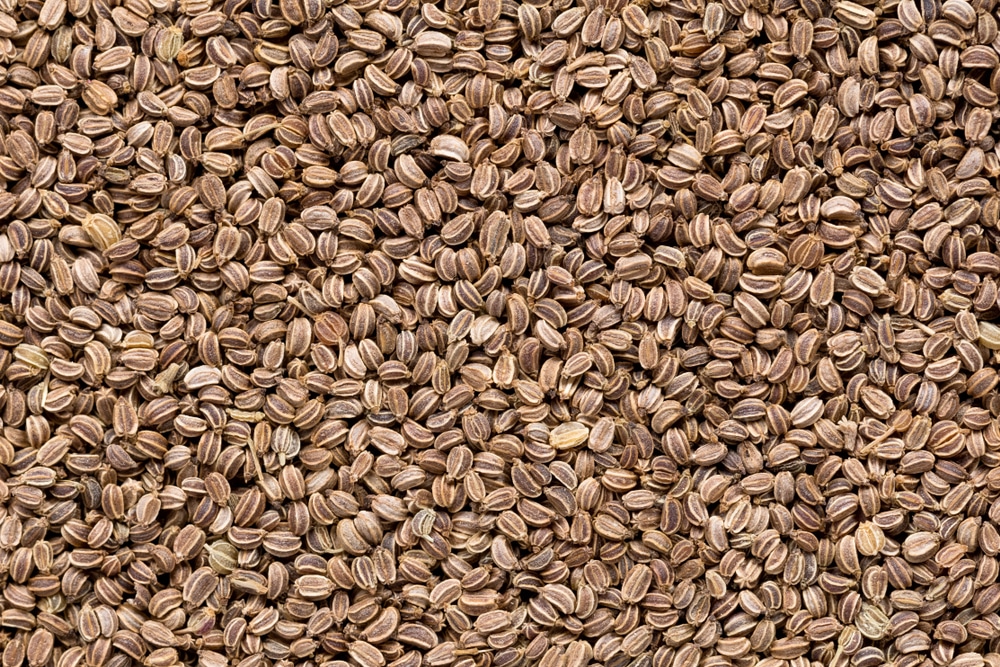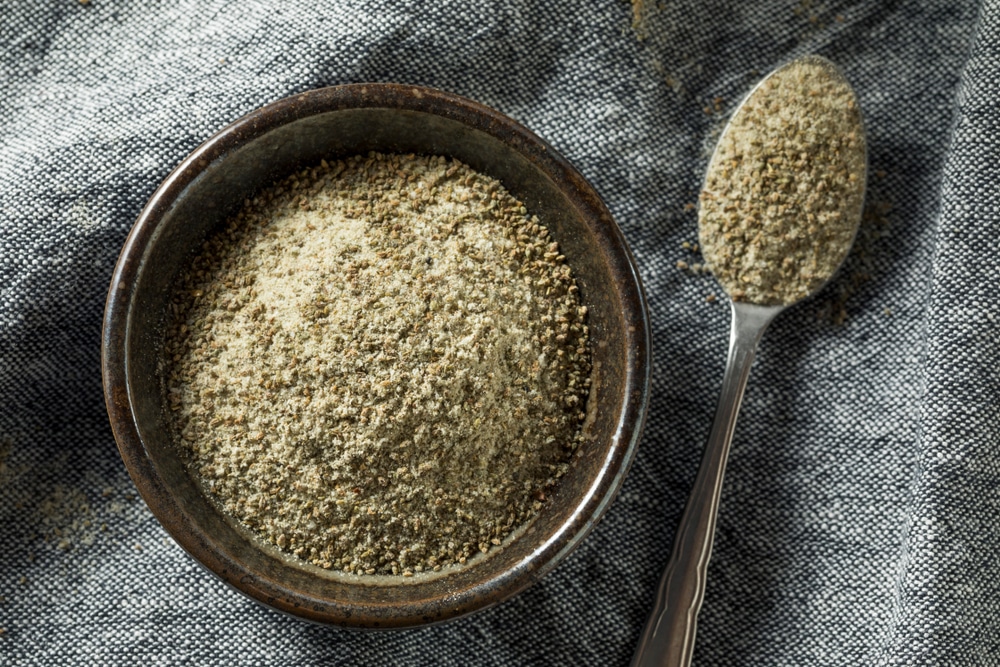Is celery seed the same as celery salt?
The main difference between celery seed and celery salt is simply the quantity of salt added. The seeds and salt taste like celery, with the same aromatic, savory, and earthy flavor that can become bitter. Celery is astringent and similar to mustard or onion, with a bit of hotness that pairs well with certain other vegetables or fruits, like tomatoes.
Flavor
- Celery seeds are more intense in flavor, with a peppery, unique taste that not everyone enjoys.
- Celery salt is more muted in flavor since it’s two parts salt, one part celery seed. But you can easily make your own!
- Overall, both give a unique flavor that’s different from regular salt and pepper used to season dishes.
Shelf life
- Whole celery seeds retain their flavor for about half a year; once ground, it lasts only three months, or even less.
- It’s recommended to buy whole seeds then grind them at home. Or, buy the seeds in small quantities and store them in a cool, dry place.
Texture
- The texture between celery seeds and salt is different. The seeds are thicker and crunchier, whereas the salt is ground finely.
- The meal can become sandy or gritty since celery seeds are small. If you’re not looking for that texture in your dish, you can grind the seeds down. Or, pair the seeds with another preferable small spice.
Appearance
- Whole celery seeds are small and brown, resembling poppyseeds.
- Celery salt looks similar to normal salt, coarse granules mixed with green celery flakes, or the dried herb from dehydrated fresh celery.
Health benefits
- Celery is packed with nutrients, supporting your bone health and blood sugar levels.
- In addition, celery promotes detoxification, lowers blood pressure, steadies heartbeat, and promotes healthy veins.
- Celery seeds are high in iron, calcium, and manganese and can help fight against arthritis, muscle spasms, and anxiety.
Comparison Table Between Celery Seed and Celery Salt
| Celery Seed | Celery Salt |
| Can be ground to make a powder, used in sauces, if you don’t want the crunch of seeds. Green-brown in color. | Ground celery seeds with salt added. Versatile and can add extra flavor to dishes. |
| Achieves celery flavor without the bulk of the actual vegetable. Adds depth and savoriness. | Subtle celery flavor, and you will need to adjust the quantity of salt when using. |
| Use the same amount of seeds as it states for celery salt. | Use more dried celery than salt (for example, two teaspoons of salt is equivalent to 4 teaspoons of dried celery flakes plus one teaspoon of regular salt). |
Where Does Celery Seeds Originate From?
Celery seeds come from wild celery, called lovage, an ancestor of the celery people can buy in markets. They provide a vegetable, herbal undertone to any dish, whether it’s soup, stew, or seafood.
Wild celery grows in marshy conditions, which contributes to the strong taste. This species of celery has a more potent flavor in the stalks and its leaves, compared to regular celery accessible for customers to buy. Various cuisines use celery seed, from French to Italian.
This spice comes in a wide variety, used in salads, sauces, dressings, brines, and dry rubs. Celery salt, on the flip side, is not the same thing. This salt is a blend comprising two parts salt and one part ground celery seed. Fun fact, celery salt is a must-have ingredient for Bloody Mary beverages but can be used in potato salads, coleslaw, and more.
Can You Use Celery Seed in Place of Salt?
Yes, there is no reason why you can’t substitute celery seed for celery salt. Be aware that if you’re adding celery salt to your dish, do not add more regular salt, or you’re looking at a very salty final product. You can swap either with little worry since celery salt is crushed celery seed with salt added. But the celery flavor might be lacking if you opt for salt compared to seeds.
Dried celery flakes are another possibility if you need a flavor substitution. If you want a slight crunch, go for whole coriander seeds. Dill seeds are another option, giving your dish a sweet, citrusy, and earthy flavor. Add the same amount of spice, whether it’s fresh or dried.
Of course, actual celery has a fresh, peppery flavor that’s more intense than dried celery or celery seeds. You can chop up the celery as large or small as you’d like or grate it if you want a fine texture. Fresh celery only works with specific recipes and only if you don’t mind a chunky texture, such as in stews or casseroles.
If you use fresh celery, don’t forget the salt, which can be another substitute for celery salt, but it simply misses the warmth, depth, and intense flavor that celery gives to a dish. You can add a dash of white pepper to achieve this if you only have regular salt.
You can also pair celery seeds with ginger since those flavors compliment each other well. Celery powder is also readily available. However, it can be more bitter than the other previous options.
What is Celery Seed?

Celery is a stem vegetable with a long, cool growing season and a finicky nature. Celery is biennial, or after planting the celery seed, it spends one growing season developing, then the second flowering and producing seeds. You can consume all parts of the celery, and it’s well known and widely available.
The celery stalks have a crunchy texture and a delicate flavor, and a few commercially grown celery farms blanch their plants or block them from light for a week or two before harvest, resulting in a lighter, milder flavor. However, darker green celery has a more robust taste. It is also more nutritious, but with a tougher outside.
In regards to flowering and seed production, celery flowers blossom in flat disks and multiple clusters with small white petals and a pleasant scent. The seeds are tiny and vary in shade from tan to dark brown. Of course, when not used for seasoning or cooking, you can plant the seeds to produce more celery.
Celery seed comes as whole seeds or ground and is often used when making barbecue sauces, homemade ketchup, marinades, or for brines and pickling. Seeds are preferable when preparing dry rubs and dressings. The Romans discovered celery centuries ago, but it’s used globally in the 21st century, especially in Western dishes.
How to Use Celery Seed
Because celery seeds have the strongest flavor compared to the other parts of the celery plant, they go well with grilled or slow-cooked chicken, seafood such as shrimp or lobster, eggs, and ribs. You can even toss a few into a vinaigrette to enunciate that herbal flavor in your salad.
Stews and barbecue sauces are other viable options, along with soups and the occasional, subtle dessert, like a citrus salad. The flavor can be more lemony, citrusy, or aromatic, depending on where the celery was imported from. Celery seeds, once ground, are often used in various types of sausages, like salami.
What is Celery Salt?

Celery salt is a variation of regular salt with simply ground, fresh, dried celery leaves from the stalk added. The flavor is not overpowering and can be used with various seasoning blends. The process is relatively straightforward to make celery salt. After drying out cut pieces of celery, they’re crushed, then salt is added and stirred until you achieve the flavor you’d desire.
How to Use Celery Salt
We can use celery salt in various ways, similar to seeds. Egg and tuna salad are popular dishes that contain celery salt, but you can even add some spice to Chicago-style hot dogs, topped with mustard, relish, onion, tomato, and pickles.
Or, as previously mentioned, alcoholic beverages like a Bloody Mary work well with celery salt. Chicken, french fries, and other vegetables often call for this spice, adding flavor without heat.
The flavor of celery salt is dependent on what salt you use, such as table or sea salt. Both dissolve differently. Salt enhances the flavors of foods when combined, and with celery, it enunciates the herbal or citrus notes, becoming more savory.
Conclusion
The biggest thing to keep in mind if you’re contemplating using celery seeds over celery salt, or vice versa, is that the seeds have more of the celery flavor while the salt is just that: salty. Be wary of overindulging in the saltiness department, or you’re looking at a dish that won’t be too pleasant.
You might also be interested in: Pickling vs kosher salt comparison.







